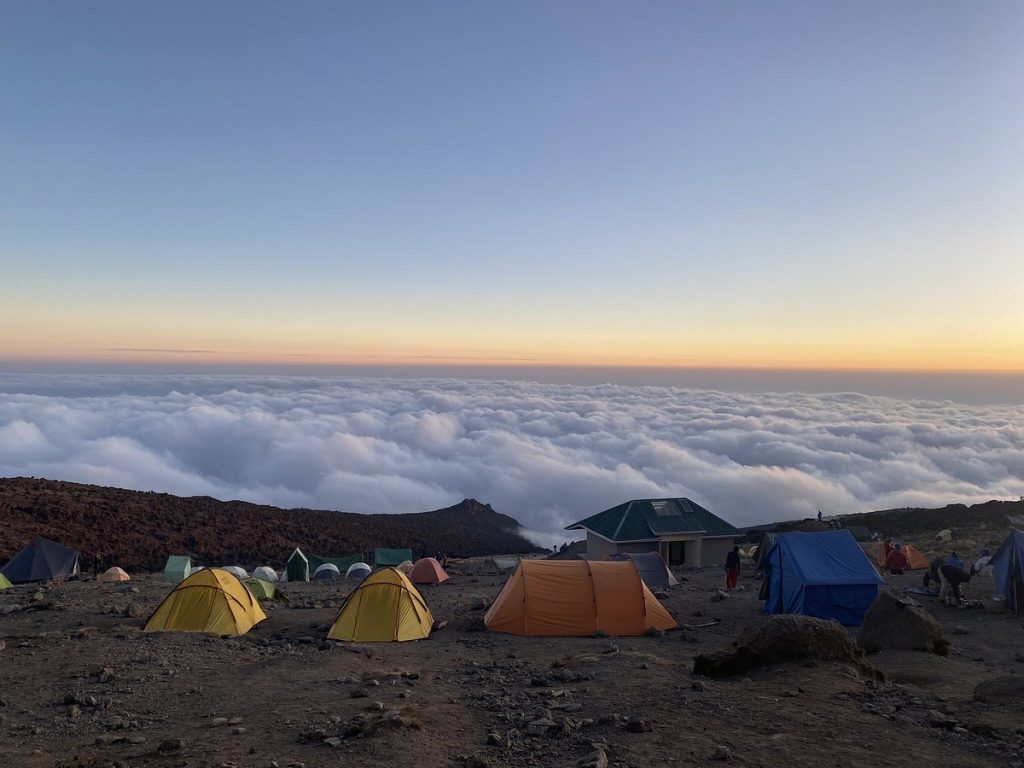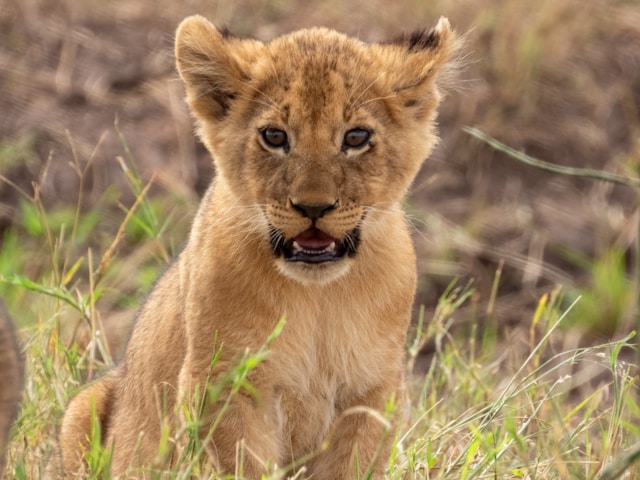Many travelers who like to visit Africa and especially Tanzania for a trip, they always wonder which wildlife animals they will see, sometimes they convince the tour guides to take them to the best places in the reserve so that they can see the animals that live in these parks. Today we have brought you some wildlife animals that it would be good to get to know before visiting Tanzania for a safari, welcome to learn about the animals found in Tanzania during your journey with us Jolita Safari.
Antelopes
Bushbuck
(Tragelaphus scriptus)
Swahili: Pango
Although the small bushbuck antelope exists in fairly large numbers in most of Tanzania’s game parks, it is a shy, solitary animal and is rarely sighted.
Standing at about 80 cm at the shoulder, the bushbuck is chestnut to dark brown in colour with a variable number of white vertical stripes on the body between the neck and rump, as well as (usually) two horizontal white stripes lower down which give the animal a ‘harnessed’ appearance. There are also a number of white spots on the upper thigh and a white splash on the neck. Females are reddish brown. Horns are usually only grown by males but females have been known to grow them on rare occasions. They are lyre shaped with gentle spirals and average about 30 cm in length.
Bushbuck are rarely found in groups of more than two and prefer to stick to areas with heavy brush cover. When startled they take off and crash loudly through the undergrowth, They are nocturnal animals and browsers yet rarely move far from their chosen spot. Though shy and elusive they can be aggressive and dangerous when cornered. Their main predators are leopards and pythons.
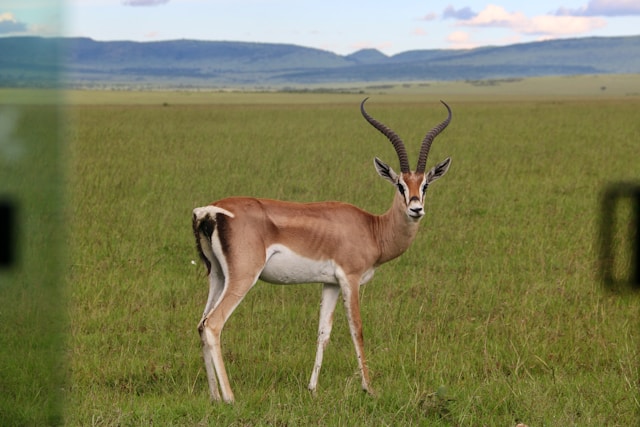
Dik-Dik
Kirk’s dik-dik (Madoqua kirki)
Swahili: dik-dik
Kirk’s dik-dik is the more common of the two dik-diks found In Tanzania and is commonly seen in Mikumi, Serengeti, Tarangire and Lake Manyara, Ruaha and Selous reserves. Its name comes from the ‘zic-zic’ call it makes when alarmed.
The dik-dik is a tiny antelope, standing only around 35 cm at the shoulder. It is a reddish-brown colour on the back, with lighter flanks and white belly. Size is usually the easiest way to identify a dik-dik, but other telltale marks are the almost total lack of a tail and the tuft of dark hair on the forehead. Horns (found on the males only) are so short (around six cm) that they are often lost in the hair tuft.
Dik-diks are usually seen singly or in pairs and are often found in exceedingly dry places – it seems they don’t have a great dependence on water. They are territorial creatures, each pair occupying an area of around five hectares. They are mainly nocturnal but can be seen grazing in acacia scrub in the early morning and late afternoon; like so many animals they rest in the heat of the day.
The females bear a single offspring twice a year. After six months the young dik-dik reaches sexual maturity and Is then driven out of the home territory.
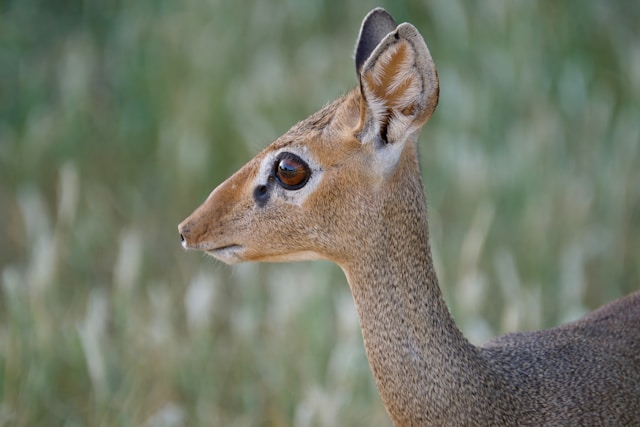
Duiker
Common as bush duiker (Sylvicapra grimmia)
Swahili: Minde
This is the most common of the duikers, of which there are at least 10 species. Even so, they are not often sighted as they are largely nocturnal, usually only live in pairs and prefer areas with good scrub cover. They are Imown to exist In Tarangire, Serengeti and Selous.
The duiker stands only 60 cm at the shoulder, is a greyish light-brown colour with a white belly and a dark brown vertical stripe on the face. The horns (males only) are short (around 20 cm), pointed. and grow straight.
Duikers are widely distributed and can be found in a variety of habitats ranging from open bush to semi-desert and up to the snow line of the highest mountains except for bamboo forest and rainforest. This ability to survive In many different habitats explains their survival In cultivated areas where other herbivorous species have been exterminated.
They are almost exclusively browsers and only rarely eat grasses though they appear to supplement their diet with Insects and guinea fowl chicks, They are capable of doing without water for long periods but will drink It when available.
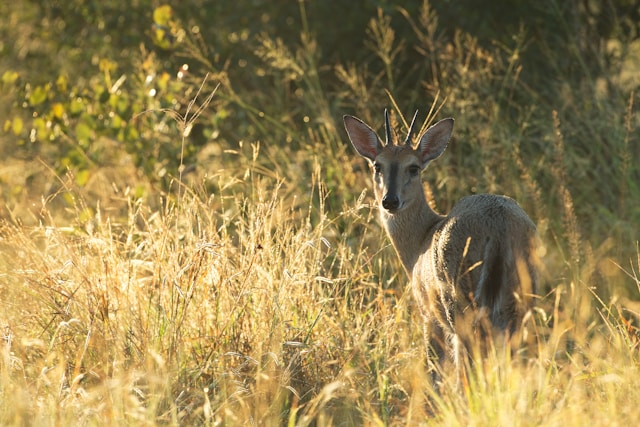
Eland
(Tragelaphus oryx)
Swahili: Pofu
The Eland looks similar to some varieties of Cattle seen on the Indian subcontinent and is found in Serengeti, Tarangire and Ruaha national park.
The biggest of the antelopes, the eland stands about 170 cm at the shoulder and a mature bull can weigh up to 1000 kg. Horns are found on both sexes and these are spiralled at the base, swept straight back and grow to about 65 cm. Males have a much hairier head than the females, and their horns are stouter and slightly They are a light greyish-brown in colour, and bear as many as 15 vertical white stripes on the body, although these are often almost indistinguishable on some animals.
The eland prefers savannah scrub to wide open spaces but also avoids thick forest. It grazes on grass and tree foliage in the early morning and late afternoon and is also active on moonlit nights. It needs to drink once a day but can go for a month or more without water if its diet includes fodder with high water content.
Eland is usually found in groups of around six to 12, but there may be as many as 50 in a herd. A small herd normally consists of several females and one male, but in larger herds, there may be several males, and there is a strict hierarchy. Females reach sexual maturity at around two years and can bear up to 12 calves in a lifetime. The young are born in October-November.
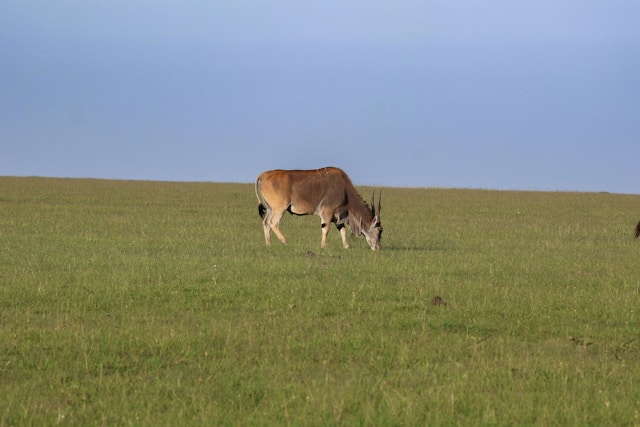
Grant’s Gazelle
(Gazella grant)
Swahili: swala granti
This is one of the most common antelopes and exists In large numbers in Tanzania. Serengeti, Tarangire, Lake Manyara, Mikumi and Selous game reserve.
Grant’s gazelle are most easily Identified by their colouring and long horns: sandy brown on the back, clearly demarcated from a lighter colour on the flanks and white belly, and white around the tail and hind legs. They are not a large gazelle. standing around 90 cm at the shoulder.
Horns are found on both sexes and are heavily ridged with around 25 rings: In the male they grow to around 60 cm (although they often appear longer because of the relatively small body) and curve gracefully and evenly up and back usually with some outward curving as well: in the female the horns are much shorter but follow the same pattern.
You usually come across herds of Grant’s gazelle In an open grassy country where there is some forest cover, although they are also occasionally found In heavily wooded savannah country. Herd size Is usually between 20 and 30 with one dominant male, does and young. Food consists mainly of leaves and grass. As water is obtained through dietary intake these gazelles do not need to drink.
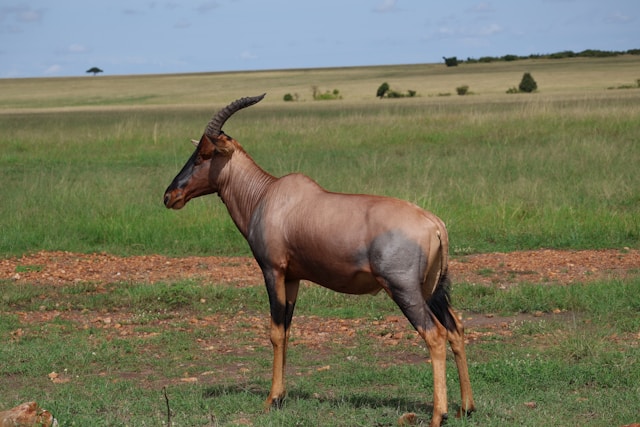
Greater Kudu
(Tragelaphus strepsiceros)
Swahili: tandala mkubwa
The greater kudu is one of the largest of the antelopes but it’s a rare sight and only found in any numbers in Serengeti national park and Selous game reserve, kudu prefer a hilly country with fairly dense bush cover. The kudu stands around 1.5 metres at the shoulder and weighs up to 250 kg yet It’s a very elegant creature, light grey in colour, with broad ears and a long neck. The sides of the body are marked by six to 10 vertical white stripes and there is a white chevron between the eyes. Horns are carried only by the males and are both divergent and spiralling.
Kudu lives in small herds of up to four or five females with their young but these often split up during the rainy season. The males usually solitary though they band together into small herds.
They are mainly browsers and only seldom eat grasses but are capable of eating many types of leaves which would be poisonous to other animals. Although somewhat clumsy animals when on the move, they are capable of clearing well over two metres when jumping.
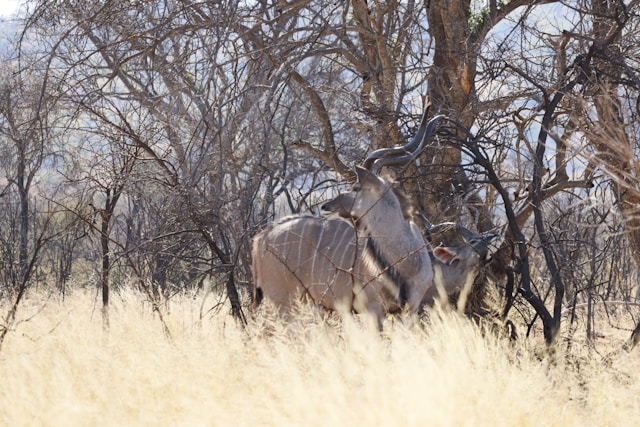
Hartebeest
(Alcelaphus buselaphus)
Swahili: Kongoni
The hartebeest is a medium-sized antelope and is found in Serengeti, Tarangire, Mikumi and Ruaha parks. It is easy to recognise as it has a long, narrow face and distinctively angular short horns (on both sexes) which are heavily ridged. Colouring is generally light brown on the back, becoming paler towards the rear and under the belly. The back slopes away from the humped shoulders. They prefer grassy plains for grazing but are also found in lightly treed savannah or hills. The hartebeest feeds exclusively on grass, and usually drinks twice daily, although it can go for months without water if necessary. They are social beasts and often intermingle with animals such as zebras and wildebeest. Their behaviour is not unlike the wildebeest’s, particularly the head tossing and shaking.
Sexual maturity is reached at around 2 and half years and calving goes on throughout the year, although there are peak periods in February and August. Predators are mainly the large cats, hyenas and hunting dogs.
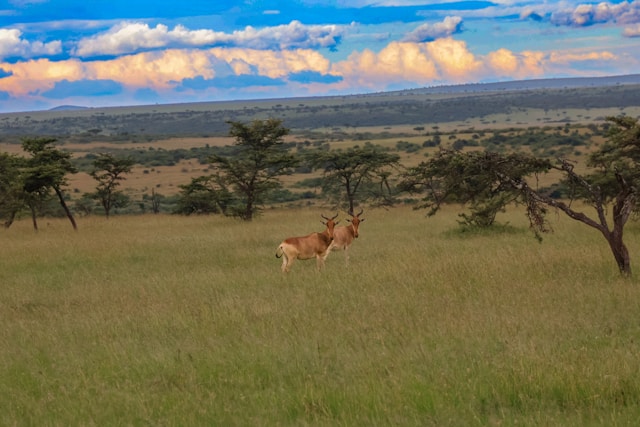
Gerenuk
(Litocranius walleri)
Swahili: Swala
The gerenuk is probably the easiest of all antelopes to identify because of its inordinately long neck, which accounts for its Swahili name, Swala Tiga, meaning giraffe-gazelle. Its distribution is limited to Mikumi, Tarangire and Serengeti national parks.
Growing to around 100 cm at the shoulder, the gerenuk is a dark fawn colour on the back which becomes much lighter on the sides and belly. The horns (found on the male only) curve gently backward and grow up to 40 cm long.
The gerenuk’s habitat ranges from dry thorn bush country to semi-desert and its food consists mainly of the tender leaves and shoots of acacia bushes. It is quite capable – in the same way as a goat -of standing on its hind legs and using one of its forelegs to pull down the higher branches of bushes to get at the leaves and shoots. Also like goats, they are quite capable of doing without water.
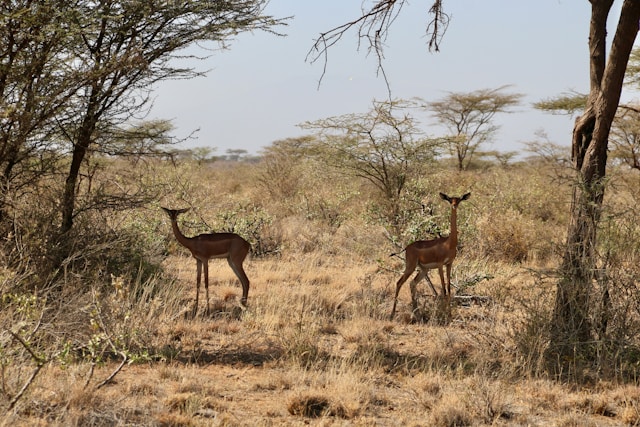
Impala
(Aepyceros melampus)
Swahili: swala pala
The graceful impala is one of the most common antelopes and is found in virtually all national parks and reserves in large numbers.
A medium-sized antelope, it stands about 80 cm at the shoulder. The coat is a glossy rufous colour though paler on the flanks with the underparts, rump, throat and chin being white. A narrow black line runs along the middle of the rump to about halfway down the tail and there’s also a vertical black stripe on the back of the thighs but, unlike in Grant’s gazelle, this does not border the white buttocks. It’s also distinguishable from Grant’s gazelle by having a tuft of long black hair above the heels of the hind legs. Only the males have horns which are long (averaging 75 cm). lyre-shaped and curve upwards as they spread.
Impala are gregarious animals with each male having a ‘harem’ of up to 100 females, though more usually around 15 to 20. Males without such a ‘harem’ form bachelor groups. There is fierce fighting between males during the rutting season but otherwise, they are fairly placid animals.
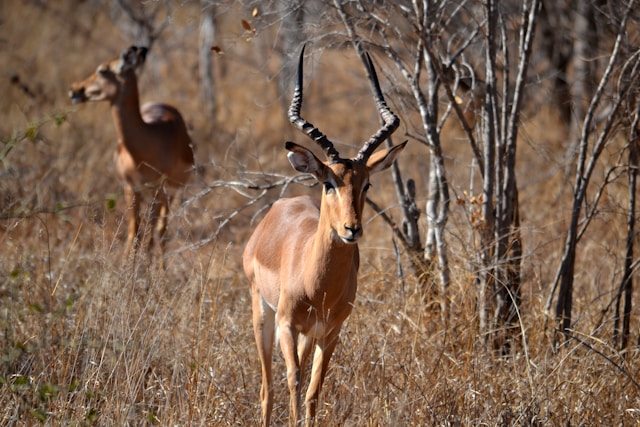
One of the most noticeable characteristics of impala is their speed and prodigious ability at jumping. They are quite capable of clearing 10 metres in a single Jump lengthwise or three metres in height and this they frequently do even when there are no obstacles in their path.
Impala is both browsers and grazers and is active during the day and by night. They are quite highly dependent on water but are capable of existing on just dew for fairly long periods. Their main predators are leopards, cheetahs and hunting dogs.

